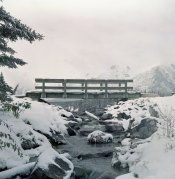That said, I do also know that blixes aren't stable, and work WORSE overall than a separate bleach and fix, but part of my question is HOW much worse are they, and would that be enough to trip up digital ice?
Let me start by saying that I have a lot of experience in C-41 processing, and what we call "process control" in particular. And also, that I have almost no practical experience working with ice.
Regarding how much better/worse, I'd say that no legitimate commercial lab would work with a C-41 "blix," as compared to separate bleach and fix. There are several reasons, but a primary one is that the bleaching portion in a standard system needs to always be in an adequately aerated condition (the act of bleaching "uses up" some of the bleaching capability, and this is restored by aerating the chemical solution). Now, the problem with a combined blix is that the conventional fixing portion uses sulfite ion as a preservative, and this sulfite is destroyed by aeration. So the act of optimizing one component is essentially killing the other. This sort of thing, the use of a film blix, is probably ok for very limited usage, but I don't have actual experience with it. The sort of processing machines where most of my experience is actually needed to have continuous aeration going on, right in the processing machine. Without this aeration it would be only 20 of 30 minutes of processing before bleaching deficiencies would become apparent in what are known as process control strips. Note that the control strips have special test patches for detection of a bleaching weakness, so they can spot a problem before typical film is affected. Note that using these strips requires a color densitometer, something that hobbyists don't generally have. Fwiw you can read about the test procedure in Kodak Z131, near the end of the document as I recall.
I should probably mention that a combined blix is perfectly acceptable for PAPER processing; the bleaching requirement is much less than for FILM so these problems don't show up.
Further to that, how exactly is bleach effectiveness measured?
There are a handful of ways to do things. I'll skip the control strips, as well as chemical testing, and go to what a hobbyist might do. A few people seem to have IR scopes. A proper scope, viewing film in the "dark," via an IR light source should see perfectly clear film. If there is any residual silver, whether silver halide or metallic silver, it will be visible with the IR scope. So if ANY trace of an image is seen via IR scope then you know that the blix was inadequate. Now, your digital ice scanner might be able to do the same thing - if you can look at the IR channel it would ideally be clear. So this might be a good way for you to spot inadequate bleaching.
The other test is to rebleach and refix (or reblix) the film, with "known-good" chems, looking for a visual change. If there is ANY visible change this means that the original blix was inadequate. That's pretty much it for the standard test methods.
A few things you should understand: there are two parts of the bleach/fix routine. First is the bleaching of the metallic silver. If the film was heavily exposed there is a lot of metallic silver; this puts a heavy demand on the bleach. So it is possible that your bleach works fine for a normally exposed roll, etc., but it fails for heavily exposed film. The second part is for the fixing portion to remove the remaining silver halide - the parts that were never developed as well as the metallic silver that was bleached. Now, in either case all silver should ultimately be removed by the fixer. So the amount of exposure should not affect the fixing component. But in the case of a blix I'm guessing that a slow-working bleach-component might not leave enough time for the fixer to pick up all of the bleached silver. I can't say for sure, just guessing.
So the bottom line, as a casual user, your only conclusive test might be to do a rebleach/refix test. (The way to do this is to sacrifice one frame. Slice it in half and re-treat one half. Then butt the two halves together on a light table - differences should be fairly obvious.) If you wanted to test your blix for any reserve capacity, independently of processing any good film, I'd suggest to process a short piece of exposed film, but pull it out of the blix a little early. Then do the reblix test. If it looks good then you know that the blix has at least a little reserve capacity. In other words if you can get complete blixing in, say 3/4 of the spec time, then you can feel more confident in your blix.
If I'm not being clear enough I'll be glad to elaborate; just ask.





